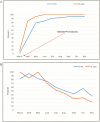Assessing Inactivated Polio Vaccine Introduction and Utilization in Kano State, Nigeria, April-November 2015
- PMID: 28838186
- PMCID: PMC5844228
- DOI: 10.1093/infdis/jix044
Assessing Inactivated Polio Vaccine Introduction and Utilization in Kano State, Nigeria, April-November 2015
Abstract
Background: Kano State, Nigeria, introduced inactivated polio vaccine (IPV) into its routine immunization (RI) schedule in March 2015 and was the pilot site for an RI data module for the National Health Management Information System (NHMIS). We determined factors impacting IPV introduction and the value of the RI module on monitoring new vaccine introduction.
Methods: Two assessment approaches were used: (1) analysis of IPV vaccinations reported in NHMIS, and (2) survey of 20 local government areas (LGAs) and 60 associated health facilities (HF).
Results: By April 2015, 66% of LGAs had at least 20% of HFs administering IPV, by June all LGAs had HFs administering IPV and by July, 91% of the HFs in Kano reported administering IPV. Among surveyed staff, most rated training and implementation as successful. Among HFs, 97% had updated RI reporting tools, although only 50% had updated microplans. Challenges among HFs included: IPV shortages (20%), hesitancy to administer 2 injectable vaccines (28%), lack of knowledge on multi-dose vial policy (30%) and age of IPV administration (8%).
Conclusion: The introduction of IPV was largely successful in Kano and the RI module was effective in monitoring progress, although certain gaps were noted, which should be used to inform plans for future vaccine introductions.
Keywords: Inactivated polio vaccine; immunization information systems; routine immunization; vaccination introduction.
© The Author 2017. Published by Oxford University Press for the Infectious Diseases Society of America.
Figures





References
-
- Hampton LM, Farrell M, Ramirez-Gonzalez A et al. . Cessation of trivalent oral poliovirus vaccine and introduction of inactivated poliovirus vaccine—worldwide, 2016. MMWR Morb Mortal Wkly Rep 2016; 65:934–8. - PubMed
-
- World Health Organization. Introduction of inactivated polio vaccine (IPV) in routine immunizations. Geneva: World Health Organization, 2014.
-
- National Federal Ministry of Health (FMOH) and National Primary Health Care Development Agency (NPHCDA). National routine immunization strategic plan 2013–2015. 2014.
-
- Cochi SL, Hegg L, Kaur A, Pandak C, Jafari H. The Global Polio Eradication Initiative: progress, lessons learned, and polio legacy transition planning. Health Aff (Millwood) 2016; 35:277–83. - PubMed
-
- Health Information Systems Program. District Health Information System version 2. Accessed at https://www.dhis2.org/.
Publication types
MeSH terms
Substances
Grants and funding
LinkOut - more resources
Full Text Sources
Other Literature Sources
Medical
Research Materials
Miscellaneous

